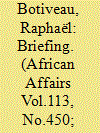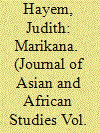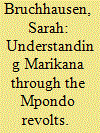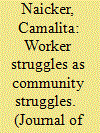|
|
|
Sort Order |
|
|
|
Items / Page
|
|
|
|
|
|
|
| Srl | Item |
| 1 |
ID:
131835


|
|
|
|
|
| Publication |
2014.
|
| Summary/Abstract |
MORE THAN A YEAR AFTER the South African police killed 34 strikers in Marikana, labour unrest continues across the country's mining sector. Industrial actions have targeted platinum giants like Amplats, the world's largest producer, where an 11-day strike over planned retrenchments has just ended and another is looming amid fresh wage talks. Rivalry between the National Union of Mineworkers (NUM) - aligned with the African National Congress (ANC) - and the more recent and militant Association of Mineworkers and Construction Union (AMCU) has also plagued the industry. On 17 October, an NUM branch chairperson at Lonmin - the third largest platinum producer in the world - was shot dead. Another Lonmin NUM shaft steward died in a similar situation on 3 November. A few months ago a former NUM leader who had become the AMCU regional representative in Rustenburg was ambushed - one of several from both sides assassinated since the Marikana massacre. In other words, the 'Framework Agreement for a Sustainable Mining Industry', promoted by South African Deputy President Kgalema Motlanthe and signed by parties to the industry on 3 July 2013, has so far failed to restore peace to the mining sector in Africa's largest economy.
|
|
|
|
|
|
|
|
|
|
|
|
|
|
|
|
| 2 |
ID:
144807


|
|
|
|
|
| Summary/Abstract |
This article analyses some of the reasons for the violent repression of the miners’ strike in Marikana, South Africa, in which 34 people died on 16 August 2012. It explores the economic and productive context which led the Rock Drill Operators to demand a wage increase outside the usual wage-bargaining structures. It goes on to examine the strikers’ subjectivity and the principles of their strike. Because the strike was organised independently of the main union, the National Union of Mineworkers, by miners demanding direct talks with their employer, as a sign of recognition, it illustrated a crisis of representation and embodied an alternative politics. The author argues that the African National Congress government was faced with a challenge to its instituted forms of political representation and, as a result, ordered the police to fire on the demonstrators.
|
|
|
|
|
|
|
|
|
|
|
|
|
|
|
|
| 3 |
ID:
140116


|
|
|
|
|
| Summary/Abstract |
The purpose of this article is to demonstrate some of the ways in which rural histories can enhance our understanding of both rural and urban resistance, both past and present, in contemporary South Africa. In order to do so, it explores two books in conversation with each other, Thembela Kepe and Lungisile Ntsebeza’s edited volume Rural Resistance in South Africa: The Mpondo Revolts after Fifty Years as well as Peter Alexander, Thapelo Lekgowa, Botsang Mmope, Luke Sinwell and Bongani Xezwi’s Marikana: A View from the Mountain and a Case to Answer. These two books provide a useful platform from which to engage in a re-examination of rurally based protest and repression in order to locate some of the suggestive links, particularly in regard to the transmission of repertoires of struggle, between the Marikana strike and the Mpondo revolts, as well as the on-going struggles of the organised poor in some of South Africa’s urban centres.
|
|
|
|
|
|
|
|
|
|
|
|
|
|
|
|
| 4 |
ID:
144806


|
|
|
|
|
| Summary/Abstract |
This article deals with the changing spatial landscape of the mines in the post-apartheid era. It is here that the link between worker and community struggles becomes apparent, given the changing nature of space and community on the mines. It becomes more difficult to deny women’s roles and contributions to political life on the mines in South Africa when we are confronted with the Marikana massacre. For the first time, women on the mines made a public statement about living and working and being on the mines, a realm of experience previously ignored or silenced in most labour historiography. After the 1980s, mine compounds were ethnically desegregated and post-1994, mine companies began to offer a living out allowance (LOA) to mineworkers who preferred not to stay in the hostels. As a result, there was an immediate growth of shack settlements around the platinum belt. With the development of shack settlements has been the introduction of family life on the mines, which has brought with it a new form of community politics that have not been adequately addressed in the public sphere or in new labour literature. This shows how independently organised worker struggles are linked to, and reinforced by, the struggles of women and the community. More specifically the paper presents research undertaken in Marikana in November 2012 and it is an attempt to write a living history of people who currently occupy the shack settlement where most of the mineworkers involved in the 2012 strike live; it is called Nkaneng.
|
|
|
|
|
|
|
|
|
|
|
|
|
|
|
|
|
|
|
|
|